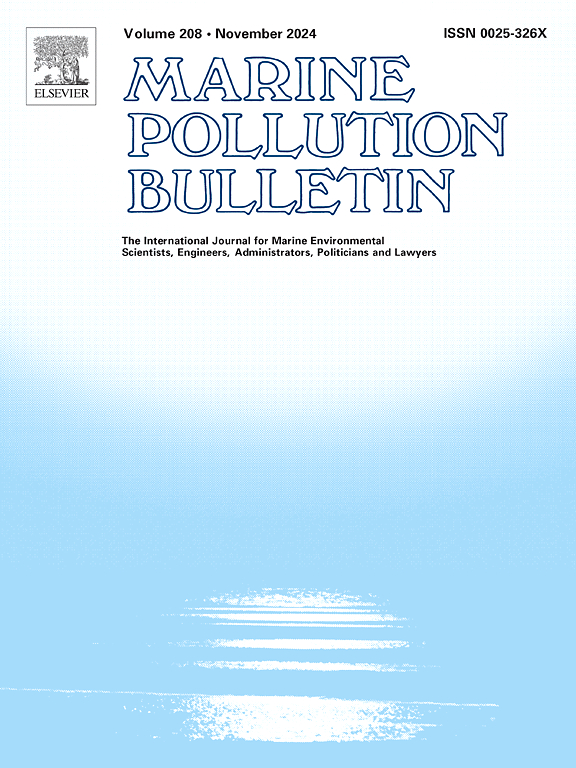高雄港沿岸底栖生态系统沉积物污染物分异及生物累积与生态风险控制因子
IF 5.3
3区 环境科学与生态学
Q1 ENVIRONMENTAL SCIENCES
引用次数: 0
摘要
为了解高污染国际商业港口高雄港周边底栖生物生态系统中污染物的命运、迁移及其影响,本研究评估了沉积物污染状况、沉积物金属的生物可利用性、底栖生物生态和营养状况,并模拟了不同底栖生物体内金属积累及其营养转移的关系。正如预期的那样,粒度影响沉积物金属的分布,细沉积物区显示出较高的人为金属输入。受污染影响,底栖生物(n = 1956)在港口入口处附近密度较低,在港口入口处和海洋出水口附近金属分布呈高MPI(10.4)和高MPI(5.43),近海呈下降趋势(2.27 ~ 4.25)。金属的生物积累在底栖生物群体中有显著差异,软体动物由于其营养地位和摄食习惯而积累更多。较低的营养水平积累了较高水平的Cu、Cr、Cd、Ni和Pb,导致生物稀释,而As和Hg则被生物放大(TMF >;1、p <;0.05),超过安全阈值,对生态和人类健康构成风险。PCA举例说明了沉积物有效金属与生物群的关系,支持它们作为生物积累的主要驱动因素的作用。该研究提供了污染物对底栖生态系统影响的综合证据,对准确估计生态风险、生物积累指数和污染管理至关重要。本文章由计算机程序翻译,如有差异,请以英文原文为准。

Sediment pollutant fractionation and controlling factors of bioaccumulation and ecological risks in coastal benthic ecosystems around Kaohsiung Harbor
To understand pollutant fate, transport, and impacts in benthic ecosystems around Kaohsiung Harbor, a highly polluted international commercial harbor, this study evaluated sediment pollution status, fractionated sediment metals for bioavailability, illustrated benthic ecology and trophic status, and modeled the relationship of accumulated metals and their trophic transfer in different benthic organisms. As expected, grain size influenced sediment metal distribution, with fine sediments areas exhibiting higher anthropogenic metal inputs. Due to the impacts of pollution, benthic organisms (n = 1956) showed lower densities near the harbor entrances and metal distribution with high MPI near the harbor entrance (10.4) and marine outfall (5.43), decreasing offshore (2.27–4.25). Metal bioaccumulation significantly differs among benthic organism groups, with mollusks accumulating more due to their trophic position and feeding habits. Lower trophic levels accumulated higher levels of Cu, Cr, Cd, Ni, and Pb, leading to biodilution, while As and Hg biomagnified (TMF > 1, p < 0.05), exceeding safety thresholds and posing ecological and human health risks. PCA exemplified the relationship of sediment available metals with biota, supporting their role as a major driver of bioaccumulation. This study provides comprehensive evidence of pollutant impacts in benthic ecosystems, crucial for accurately estimating ecological risks, bioaccumulation indices, and pollution management.
求助全文
通过发布文献求助,成功后即可免费获取论文全文。
去求助
来源期刊

Marine pollution bulletin
环境科学-海洋与淡水生物学
CiteScore
10.20
自引率
15.50%
发文量
1077
审稿时长
68 days
期刊介绍:
Marine Pollution Bulletin is concerned with the rational use of maritime and marine resources in estuaries, the seas and oceans, as well as with documenting marine pollution and introducing new forms of measurement and analysis. A wide range of topics are discussed as news, comment, reviews and research reports, not only on effluent disposal and pollution control, but also on the management, economic aspects and protection of the marine environment in general.
 求助内容:
求助内容: 应助结果提醒方式:
应助结果提醒方式:


